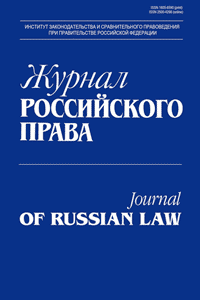Since 2013, at the State Duma initiative, each April Saint-Petersburg has hosted the “Eurasian Economic Perspective” International Forum. This discussion venue for the exchange of opinions by parliament members of the post-Soviet states, with the participation of scientists, representing humanitarian sciences and education, furthers, among other things, the goal of the states’ integration and their economic development. The topic for discussion offered this year was the implementation problems of the Treaty on the Eurasian Economic Integration as of January, 1, 2015. One of the main integration problems is the problem of unification and harmonization of national legislations of the Treaty countries. The key question of the unification process is separation of powers and competences of the integration organization’s common body and the participating countries’ national bodies. The understanding of the supranational power of the common body is not correct. The integration experience in other unions between the states proves the importance of the sovereignty principle in the integration process. The author provides the analysis of former integration experience. For example, CMEA (Council of Mutual Economic Assistance) united the former Eastern European socialist republics and South-Eastern Asia and was dissolved in 90-ies after the transition of the States — participants to market economy. Notwithstanding its dissolution, CMEA created effective integration instruments on the basis of unification of national legislations: The CMEA General Conditions of Delivery. This instrument of the socialist common market continues to be practiced as model conditions for international contracts. The legal instrument of the International Business Corporation (IBC) has initiated the movement of resources that can be compared to the movement of capital in a free-market world. The CMEA experience has provided basic knowledge of cooperation, which was later used in other integration groups. The article also covers the economic integration of the European Union. It can be useful from the point of view of critics of “federalist” theories on the nature of integration of a group of states. The latter remains, as the authors show, to be subject to the International Law system. It is quite logical, that due to this position of the authors, they pay special attention to the key role of national legislation in the integration process. On the basis of the analysis of the Andean Common Market experience the authors underline the features of integration in the Latin American region. The comparative analysis of international regional unions of states is necessary to make the work of the Eurasian International Economic Union (EAEU) more effective. The Information Law is the technique that provides the diffusion of the most effective models of regulation for the purpose of economic integration. This approach in solving problems of economic integration in EAEU seems to be useful in search of the ways to overcome difficulties of the integration process.
Information technologies, data exchange agreements, coordination of economic policy, EAEU, EU, ANCOM, CMEA (Council of Mutual Assistance), unification and harmonization of legislation, economic integration.
1. Brumer C. Minilateralism. How Trade Alliances? Soft Law? And Financial Engineering are Redefining Economic Statescraft. Cambridge University Press, 2014.
2. Deakin S., Koukiadaki A. The Sovereign Debt Crisis and the Evolution of Labour Law in Europe. Re-sociaising Europe in a Time of Crisis / eds. by N. Countouris, M. Freedland. Cambridge, 2013.
3. Fudge J. The Way Forward for Social Europe: How Do We Get There From Here?. The Modern Law Review. 2014. No. 5.
4. International Legal Materials. 1981. Vol. 20.
5. McGoldrick D. The International Legal Personality of the European Community and the EU. 50 Years of the European Treaties. Looking Back and Thinking Forward / eds. by M. Dougan, S. Currie. Oxford, 2009.
6. Nolde B. La codification du droit privé. Recneil des conrs. 1936-i, t 55. P., 1936.
7. Parra-Aranguren G. Codificacion del Derecho Internacional Privado en America Latina. Caracas, 1982.
8. Gringol´ts I. A. Zakonodatel´stvo o novoy sisteme upravleniya khozyaystvom v Narodnoy Respublike Bolgariya. Trudy VNII sovetskogo zakonodatel´stva. Vyp. 57. M., 1970.
9. Gringol´ts I. A. Pravovoe polozhenie promyshlennykh ob´´edineniy v GDR. Trudy VNII sovetskogo zakonodatel´stva. Vyp. 32. M., 1968.
10. Doronina N. G. Diffuziya v prave kak napravlenie unifikatsii mezhdunarodnogo chastnogo prava: k voprosu ob ob´´ekte informatsionnogo prava. Zhurnal rossiyskogo prava. 2015. № 5.
11. Mezhdunarodnoe chastnoe pravo: sb. dok. M., 1997.
12. Rafalyuk E. E. Regional´naya integratsiya latinoamerikanskikh gosudarstv. M., 2014.
13. Rozenberg M. G. Mezhdunarodnaya kuplya-prodazha tovarov. Kommentariy k pravovomu regulirovaniyu i praktike razresheniya sporov. 4-e izd. M., 2010.
14. Semilyutina N. G. Globalizatsiya mezhdunarodnykh khozyaystvennykh svyazey, informatsionnye tekhnologii i vykhod na novyy uroven´ diffuzii v prave. Zhurnal rossiyskogo prava. 2015. № 5.
15. Khanferyan V. Informatsionnye tekhnologii: informatsiya k svedeniyu. Rossiyskaya gazeta. 2015. 29 maya.








